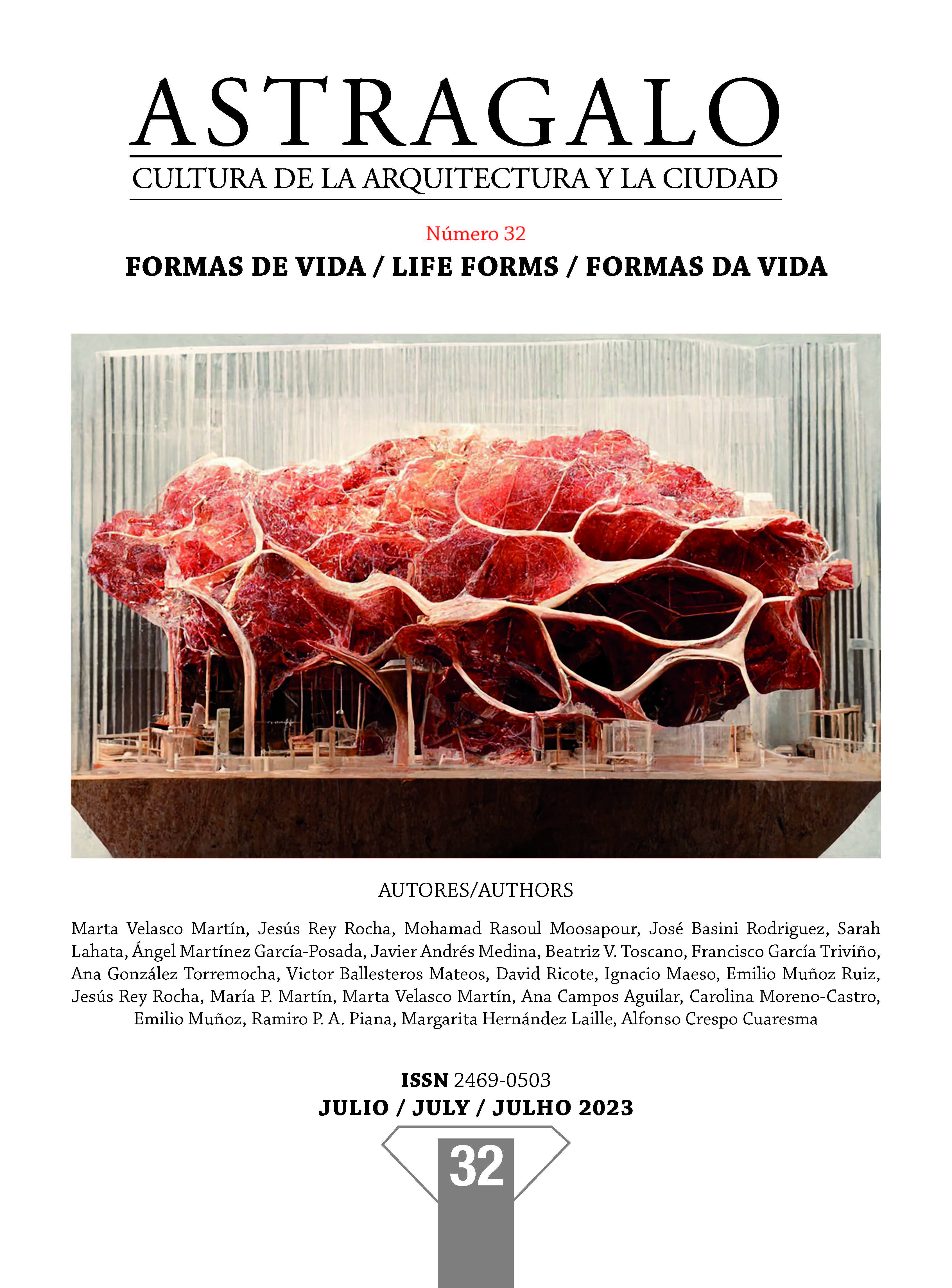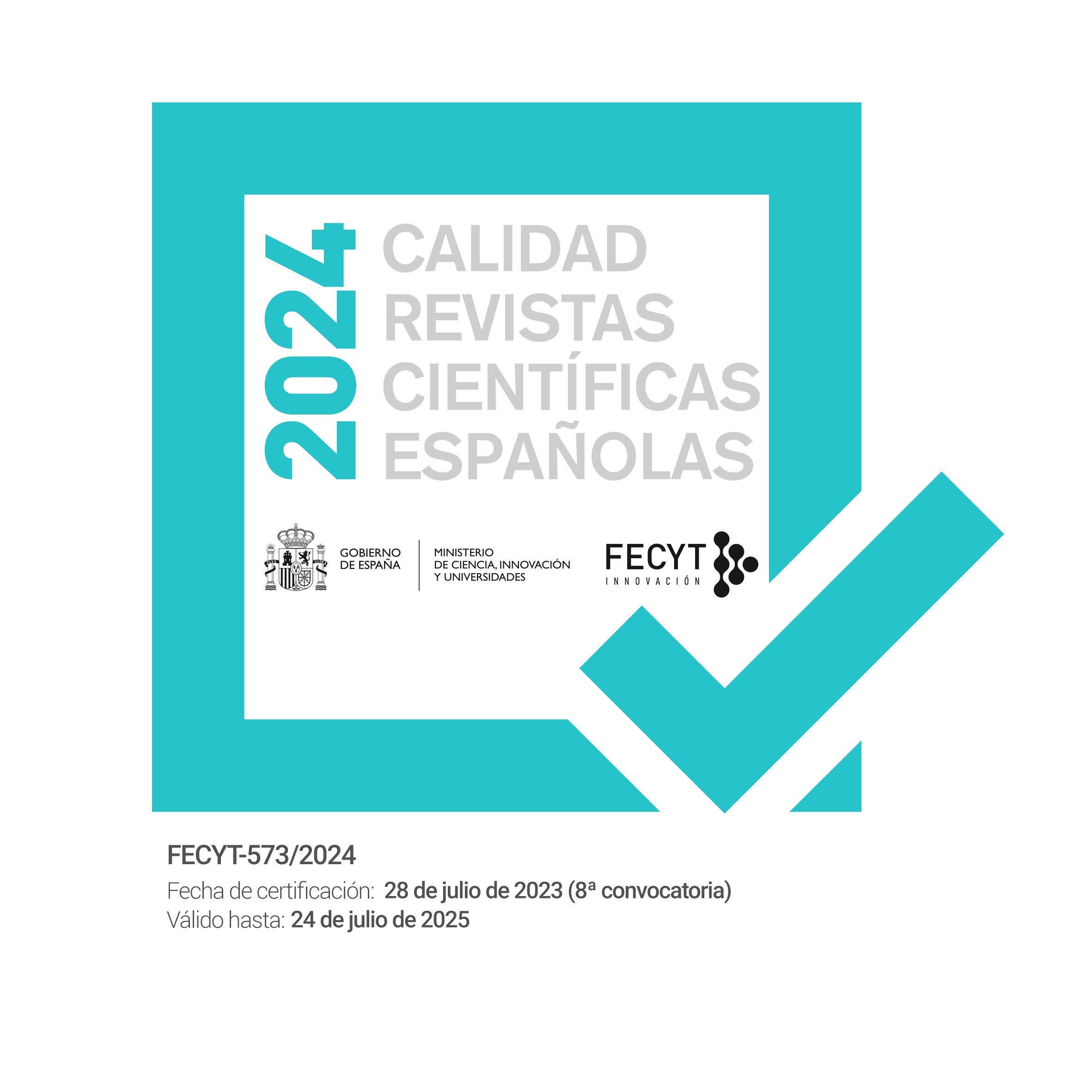Ecosofías urbanas. Marsella o la ciudad como un cuerpo sin órganos
DOI:
https://doi.org/10.12795/astragalo.2023.i32.07Palabras clave:
Felix Guattari, urbanismo, biofilia, brutalismo, Marsella, propiedad privadaResumen
Las ciudades no solo están habitadas por humanos. En ellas ha existido siempre una colaboración o pugna entre la naturaleza humana y la animal, manifiesta en la continua deriva entre dos tipos de espacio urbano: uno, el espacio planificado de la urbe, estriado por el axioma organicista de la funcionalidad y la mercantilización. El otro, es un espacio liso, espontáneo y desorganizado, producido por el desarrollo autónomo de la vida animal. Al hilo de la actual crisis ecológica se intuye a la ciudad funcional como agente del desplazamiento y obliteración de la vida animal. Más allá de lo que supone la expansión predatoria y apropiadora de la ciudad hacia el ámbito rural, la práctica del planeamiento parece carecer de claves, herramientas y tecnologías para dar cabida a formas de habitar cooperativas entre el ser humano y los animales. El siguiente artículo propone la reivindicación de una nueva Ecosofía Urbana, es decir, de un nuevo paradigma de integración biofílica de la vida urbana, que sea capaz de efectuar una desegregación física y ontológica entre la naturaleza humana y no humana en las ciudades. Se buscará la raíz de esta segregación en el proyecto de consolidación de las clases medias tras la guerra mundial y donde la obra brutalista de F. Pouillon (1912-1986) en Marsella (1949) es pionera. Partiéndose de la premisa de un necesario de-splinttering del urbanismo post-pandémico y postrero a la crisis de las clases medias en general (que contempla una crisis en la centralidad de la propiedad privada para la continuidad de clase) y a través del texto de Felix Guattari Las Tres Ecologías (1989), se abogará por un nuevo modelo de diseño urbano de reconciliación entre lo humano y lo animal.
Descargas
Citas
Amir, Fahim. 2018. Schwein und Zeit. Tiere, Politik, Revolte. Hamburgo: Nautilus.
Attia, Kadar. 2009. Ghardaia-Le Corbusier. (Internet) http://kaderattia.de/ghardaia-le-corbusier/ (Abril 2023)
Artaud, Antonin. 1947, 2013. Para terminar con el juicio de dios. El teatro de la crueldad. Buenos Aires: Editorial El cuenco de plata.
Barbieri, R. and M. Drancourt. 2018. “Two Thousand Years of Epidemics in Marseille and the Mediterranean Basin”, New Microbes and New Infections, 26: Suppl. 1, 4–S9, doi:10.1016/j.nmni.2018.08.009.
Barr, Rebecca Anne, Sylvie Kleiman-Lafton, and Sophie Vasset (eds). 2018. Bellies, bowels and entrails in the eighteenth century, Seventeenth and Eighteenth Century Studies MUP, Manchester: Manchester Scholarship Online.
Benjamin, Walter. 1972, 1990. Haschisch. Madrid: Taurus.
Beaune, Henri. 1889. Description de la peste à Aix en l'année 1580. e-Médiatheque – SHS
De Botton, Alain. Louis Kahn. Series on Art and Architecture. The School of Life. https://www.youtube.com/watch?v=b99oGua6V20 (Abril 2023)
Byers, Kaylee A. et al. 2019. "Rats about town: A systematic review of rat movement in urban ecosystems." Frontiers in Ecology and Evolution 7: 13.
Cantor, Matthew. 2023. “The miracle that disrupts order’: mathematicians invent new ‘einstein’ shape”. The Guardian, 4 Abril 2023.
Carnell, Hugo. 2022. "Historical and Modern Responses to Plague Epidemics: What Lessons Can Be Drawn from Case Studies in France, the United States and Madagascar?”. Journal of Humanitarian Affairs 4.2: 3-11.
Chapman, Brian. 1953. “Baron Haussmann and the Planning of Paris.” The Town Planning Review. Vol. 24, No. 3, Octubre, 177-192.
Cupers, Kenny. 2014. The Social Project. Housing Postwar France. Minnesota: University of Minnesota Press.
Deuze, Gilles. 1996. Lógica del sentido. Barcelona: Paidós.
Deleuze, Gilles & Guattari, Felix. 1972, 1985. El anti-Edipo : capitalismo y esquizofrenia. Barcelona: Paidós.
Foucault, Michel. 1967, 1984. “Of Other Spaces: Utopias and Heterotopias”. Architecture /Mouvement/ Continuité. Paris, Octubre, 1984. Aquí en la versión en inglés del texto original francés presentado por Foucault en 1967 en una conferencia bajo el título de “Des Espace Autres” por la traducción del francés de Jay Miskowiec.
Foucault, Michel. 2001. „Il faut défendre la société. Cours au Collège de France (1975-1976)“. https://monoskop.org/images/9/99/Foucault_Michel_Il_faut_defendre_la_societe.pdf (Abril 2023).
Fraser, Nancy. 1995. “From Redistribution to Recognition? Dilemmas of Justice in a 'Post-Socialist' Age”. The New Left Review, I/212. Julio/Agosto 1995.
Fraser, Nancy; Honneth, Axel. 2003. Redistribution or recognition?: A political-philosophical exchange. Londres, Nueva York: Verso Books.
Fraser, Nancy. 2022. Cannibal Capitalism. Londres, Nueva York: Verso Books.
Frioux, Stéphane. 2013. Les batailles de l'hygiène; Villes et environnement de Pasteur aux Trente Glorieuses. París: Presses Universitaires de France.
Graham, Stephen & Marvin, Simon. 2001. Splintering Urbanism. Networked Infrastructures, Technological Mobilities and the Urban Condition. Londres, Nueva York: Routledge.
Grammenos, Fanis; Craig, Barry; Pollard, Douglas; Guerrera, Carla. Hippodamus Rides to Radburn. 2008. A New Model for the 21st Century. Journal of urban design. Volume 13 Issue, 163 – 176. Oxfordshire: Taylor & Francis Group.
Gruet, Stéphane. 2013. Fernand Pouillon: Humanité et grandeur d'un habitat pour tous. Toulouse: Editions Poiesis.
Guattari, Felix. 1989. The Three Ecologies. Londres: The Athlone Press.
Guattari, Felix. 1995. Chaosmosis: an ethico-aesthetic paradigm. Indiana: Indiana University Press.
Guattari, Felix. 1996. The Guattari Reader. Gary Genosko (Ed.). Cambridge: Blackwell.
Haraway, Donna. 2003. The Companion Species Manifesto: Dogs, People, and Significant Otherness. Chicago: Prickly Paradigm Press.
Hammarstrand, Nils. 1928. “Hippodamus of Miletus and Greek City Planning”. Journal of the American Institute of Architects, 09/1928, Volume 16, Issue 9. 351.
Heidegger, Martin. 1951, 2015. Construir, habitar, pensar = Bauen, Wohnen, Denken. Edición de Arturo Leyte & Jesús Adrián. Barcelona: La Oficina.
Highmore, Ben. 2017. “The Art of Brutalism: Rescuing Hope from Catastrophe in 1950s Britain”. New Haven & London: Yale university Press.
Horvath, Louise Beltzung and Maicher, Markus. 2016. “Rethinking the City as a Body without Organs”. En Deleuze and the City, 33-45. Edinburgh: Edinburgh University Press.
Jokimäki, Jukka; Kaisanlahti-Jokimäki, Marja-Liisa; Suhonen, Jukka; Clergeau, Philippe; Pautasso, Marco; Fernández-Juricic, Esteban. 2011. “Merging wildlife community ecology with animal behavioral ecology for a better urban landscape planning”. Landscape and Urban Planning, Volume 100, Issue 4, 383-385.
Jordan, D. P. 1992. “THE CITY: Baron Haussmann and Modern Paris”. The American Scholar, 61(1), 99–106. http://www.jstor.org/stable/41211982
Karima, Anouche; Mohamed, Tehami (2018). “Architectural Quality through the Integration of Users' Viewpoints inArchitectural Design: Case Study Pouillon's Diar Es Saada”. Journal of Construction in Developing Countries, 23(1), 149–175, 2018.
Korbi, Marson & Migotto, Andrea. 2019. “Between Rationalization and Political Project: The Existenzminimum from Klein and Teige to Today”. Urban Planning, Volume 4, Issue 3, 299–314.
Leiderer, Annette. 2018. “The Elimination of the German Butcher Dog and the Rise of the Modern Slaughterhouse”. En Animal History in the Modern City: Exploring Liminality. Clemens Wischermann, Aline Steinbrecher & Philip Howell (Eds.), 105–126. Londres: Bloomsbury Academic.
Lindemann, Hans-Eckhard. 1991. Stadt im Quadrat Geschichte und Gegenwart einer einprägsamen Stadtgestalt. Krefeld: Vieweg Verlag.
Lizee, MH., Tatoni, T. & Deschamps-Cottin, M. 2016. “Nested patterns in urban butterfly species assemblages: respective roles of plot management, park layout and landscape features”. Urban Ecosyst 19, 205–224.
Martin, Lewis. Fernand Pouillon: The Future That Didn’t Happen
https://www.declad.com/fernand-pouillon-the-future-that-didnt-happen (8 Abril 2023)
Marx, Karl. 1871. Der Bürgerkrieg in Frankreich. Adresse des Generalrats der Internationalen Arbeiterassoziation (30. Mai 1871). Publicado por primera vez en inglés como panfleto en Londres, junio de 1871. Publicado por primera vez en alemán en Der Volksstaat, Leipzig, 28 de junio-29 de julio de 1871 y como reimpresión separada del Volksstaat, Leipzig 1871. La presente reimpresión corresponde a la última edición en alemán, editada por Friedrich Engels, Berlín 1891. Karl Marx y Friedrich Engels, Werke, Vol.17, 1962, Berlín/DDR, 313-365.
Mazza, Luigi. 2009. “Plan and Constitution: Aristotle's Hippodamus: Towards an 'Ostensive'definition of spatial planning”. Town planning review, Volume 80, Issue 2. 113-141.
Miliutin, Nikolai A. 2021. “The Avoidance of Extremes”. En Sotsgorod: The Problem of Building Socialist Cities. George R. Collins and William Alex (Eds.) https://mitp-arch.mitpress.mit.edu/pub/ci2oe5gb
Mumford, Lewis. 1937. “The Death of the Monument”. Circle: International Survey of Constructive Art, 263-270. Londres: Faber and Faber.
Nequinha, Vicente. ‘Fernand Pouillon – The Modern Master Builder’. CARTHA II/08. https://www.carthamagazine.com/wp-content/uploads/2016/05/08_CARTHA_MANNSCHAFT_NEQUINHA.pdf
Ngo, Anh-Linh & Kempe, André. 2020. “Neue Realismus in der französischen Architektur” - Editorial ARCH+: Neuer Realismus in der französischen Architektur, 240, 1-3.
Nilon, Charles H.; Aronson, Myla F. J.; Cilliers, Sarel S.; Dobbs, Cynnamon; Frazee, Lauren J.; Goddard, Mark A.; O’Neill, Karen M.; Roberts, Debra; Stander, Emilie K.; Werner, Peter; Winter, Marten; Yocom, Ken P. 2017. „Planning for the Future of Urban Biodiversity: A Global Review of City-Scale Initiatives”, BioScience, Volume 67, Issue 4, Abril, 332–342. https://doi.org/10.1093/biosci/bix012
Pasco, Allan. 1997. Sick Heroes. French Society and Literature in the Romantic Age, 1750–1850. Exeter: University of Exeter Press.
Pearson, Chris. 2015. “Beyond ‘resistance’: rethinking nonhuman agency for a ‘more-than-human’ world”. European Review of History: Revue européenne d'histoire, 22:5, 709-725, DOI: 10.1080/13507486.2015.1070122
Pouillon, Fernand. 1964. Les Pierres Sauvages. París: Éditions du Seuil.
Pouillon, Fernand. 1968. Mémoires d'un architecte. París: Éditions du Seuil.
Povinelli, Elisabeth A. 2016. Geontologies. A Requiem to Late Liberalism. Durham: Duke University Press.
Rabinow, Paul. 1995. French Modern Norms and Forms of the Social Environment. Chicago: University of Chicago Press.
Radman, Andrej. 2021. Ecologies of Architecture: Essays on Territorialisation. Edimburgo: Edinburgh University Press.
Sauvage, Henri (Edición de 1994 por Taylor & Francis). The Works of an Architect-Decorator in the Collections del Institut Francais d'Architecture y los Archivos de Paris. Volumen II. Architectural Works, c. 1905-1931. Especialmente los capítulos con el Epígrafe ‘Low Cost Housing’.
Sauvage, Henri. 1911. Six ans de lutte contre le taudis. L’œuvre de la Société Anonyme des Logements Hygiéniques à Bon Marché, París: Archives Henri Sauvage, Centre d'archives d'architectes du XIX Siecle.
Signoli, M. and Tzortzis, S. 2018. « La peste à Marseille et dans le sud-est de la France en 1720–1722 : les épidémies d’Orient de retour en Europe », Cahiers de la Méditerranée, 96, 217–30. doi:10.4000/cdlm.10903.
Sontag, Susan. 1988. Introducción a la edición por la misma autora del Antonin Artaud. Selected Writings. Berkeley: University of California Press.
Spang, Rebecca L. 1992. “‘And They Ate the Zoo’: Relating Gastronomic Exoticism in the Siege of Paris.” MLN, vol. 107, no. 4, 752–73.
Schwartz, Alexandra (2014). „Paris Reborn and Destroyed”. The New Yorker. Marzo 19, 2014.
Tafuri, Manfredo et al. 1971. Socialismo, città, architettura URSS 1917–1937; il contributo degli architetti europei (Collana di Architettura, 3). Roma: Officina Edizioni.
Tinnell, John C. 2012. “Transversalising the Ecological Turn: Four Components of Félix Guattari's Ecosophical Perspective”. The Fibreculture Journal 6: 357-388.
V.V. A.A. Revista Arch+ Número especial dedicado a la Cohabitación entre animals y humanos en el habitat urbano. 247 4/2022.
van den Heuvel, Dirk. 2015. “Between brutalists: The Banham hypothesis and the Smithson way of life”. The Journal of Architecture, 20(2), 293-308.
Voigt, Annette; E. Hauck, Thomas; Hennecke, Stefanie; Reinert, Wiebke. 2020. “Wilde Urbaniten Tier-Mensch-Regime im Habitat Großstadt”. suburban. zeitschrift für kritische stadtforschung. Band 8, Heft ½. 253-262.
Wilson, Elizabeth. 1995. “The Rhetoric of Urban Space”. New Left Review; Vol. 0, Iss. 209, Enero, 146.
Descargas
Publicado
Cómo citar
Número
Sección
Licencia
Derechos de autor 2023 Beatriz V. Toscano

Esta obra está bajo una licencia internacional Creative Commons Atribución-NoComercial-CompartirIgual 4.0.


















